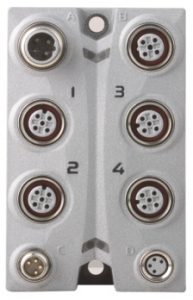
X67 Stepper Motor Module
B&R X67 Stepper Motor Module
Controlling stepper motors with IP67 protection
The new B&R X67 Stepper Motor Modules provide machine builders a more cost effective solution to controlling stepper motors. Stepper motors are still very popular among machine builders for various reasons including: high degree of torque, operation without feedback, and holding the last position when power is disconnected just to name a few of the special features of the stepper motor. The X67 stepper motor module is available in two variants based on the customer’s requirements. The highlights of the new X67 stepper motor modules can be summarized as follows:
• Integrated motor detection
• 64 microsteps
• Stall detection
• Extremely compact
• IP67 protection
Two performance classes with IP67 protection
The stepper motor module X67SM4320 is used to control up to four stepper motors with a rated voltage of 18-30 VDC at a motor current up to 1 A (1.5 A peak). The maximum step frequency is 20 kHz. The second stepper motor module variant X67SM2436 is used to control up to two stepper motors with a rated voltage of 18-48 VDC at a motor current up to 3 A (5 A peak). The maximum step frequency is also 20 kHz. Additionally, this module has six digital inputs that can be used as limit switches or as encoder inputs. Both variants are ground-breaking in their compact design. Because of their IP67 protection the modules can be mounted directly on the machine frame right next to the motor. Advantages include reduced space requirements and lower thermal loads in the switching cabinet as well as less wiring. With an input voltage range of up to 48 V, peak performance can be achieved in the range of 200 W.
Technical Data
The X67 Stepper Motor modules offer the following two control possibilities: Either using position settings from the B&R Soft NC or Soft CNC. The current position values can be checked cyclically by the PLC and be reacted to using the control program.
Microstepping
Conventional stepper motors usually have a stepping angle of 3.6 to 0.9 degrees. Although this is sufficient for many positioning tasks, a more exact division is frequently necessary. At this point, it’s currently not technologically feasible to reduce the stepping angle of the stepper motor indiscriminately. Besides that, each additional gradation increases the cost of the motor considerably.
The microstepping solution
By dividing the current in the coils, just about any division can be achieved for the stepping angle. This doesn’t just increase the positioning accuracy; the micro steps also result in smoother operation. Other measures for reducing resonance are no longer necessary.
Automatic microstep adjustment
Depending on the step frequency, the module always carries out the maximum number of possible microsteps. The internal current controller works with a maximum frequency of 40 kHz, which also makes it possible to reach a frequency of 20 kHz in half-step mode.
On a motor with a 1.8 degree stepping angle, the result is 3,000 rpm, which is generally more than sufficient for conventional applications.
Configurable motor current
By individually adjusting the coil currents, the motor is only operated with the current it actually needs. This simplifies the selection of the available motors and prevents unnecessary heating. Because the latter reduces the energy consumption and thermal load, the effects are positive on the lifespan of the entire system.
Complete flexibility is achieved by using the values for holding current, boost current and continuous current, which are completely independent of each other. The current for the microsteps is automatically adjusted to the configured current values.
Additional features
An enormous help is the automatic motor detection system at standstills. The stepper modules can identify the connected motors using their coil characteristics and generate feedback in the form of an analog value. This makes it possible to detect not only wiring errors, but incorrect motor types being used mistakenly as well.
A stall detection mechanism is integrated to analyze the motor load. The stall is recognized using a configurable threshold. This allows an overload or motor standstill to be detected precisely in many different types of applications.






